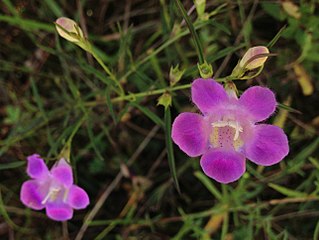
Nathaniel Lord Britton was an American botanist and taxonomist who co-founded the New York Botanical Garden in the Bronx, New York.

Anemonastrum canadense, synonym Anemone canadensis, the Canada anemone, round-headed anemone, round-leaf thimbleweed, meadow anemone, windflower, or crowfoot, is a herbaceous perennial flowering plant in the family Ranunculaceae. It is native to moist meadows, thickets, streambanks, and lakeshores in North America, spreading rapidly by underground rhizomes. It is valued for its white flowers.

Anemone virginiana is an upright growing herbaceous species of flowering plant buttercup family Ranunculaceae. It is a perennial that grows 30–80 centimetres (12–31 in) tall, flowering from May until July, the flowers are white or greenish-white. After flowering the fruits are produced in a dense rounded thimble shaped spikes 15–35 millimetres (0.59–1.38 in) long and 12 millimetres (0.47 in) wide. When the fruits, called achenes, are ripe they have gray-white colored, densely woolly styles, that allow them to blow away in the wind. The leaf structure is whorled halfway up the stem and each individual leaf appears to be deeply cut. Native from eastern North America, where it is found growing in dry or open woods. This plant can be found in 38 out of the 50 states in the U.S. and is located anywhere from Maine to Minnesota going west, and found as far south as Georgia and Louisiana.

Fimbristylis is a genus of sedges. A plant in this genus may be known commonly as a fimbry or fimbristyle. There are 200 to 300 species distributed worldwide. Several continents have native species but many species have been introduced to regions where they are not native. Some are considered weeds. These are typical sedges in appearance, with stiff, ridged stems and cone-shaped terminal panicles of spikelets. They are found in wet environments, and are most diverse in tropical and subtropical regions.

Fimbristylis miliacea, the grasslike fimbry or hoorahgrass, is a species of fimbry that probably originated in coastal tropical Asia but has since spread to most continents as an introduced species. It is a widespread weed in some areas and is sometimes problematic in rice paddies.

Fimbristylis thermalis is a species of fimbry known by the common name hot springs fimbry. It is native to the southwestern United States and northern Mexico. It has been reported from Baja California, California, Arizona, Nevada, Utah and Coahuila.

Hypericum mutilum is a species of St. John's wort known by the common name dwarf St. John's wort. It is native to parts of North America and is present in other parts as an introduced species. It is an annual or perennial herb taking a multibranched erect form up to about 60 centimeters tall. The oval green leaves are one or two centimeters long and are covered in tiny glands. The inflorescence is a compound cyme of tiny flowers. H. mutilum subsp. mutilum and subsp. boreale have a diploid number of 16, and H. mutilum subsp. boreale can have a diploid number of 18.
Fimbristylis polytrichoides is a species of fimbry known by the common name rusty sedge, native to east Africa, Madagascar, China, Southeast Asia, New Guinea and Australia. The plant is common along the coast line and estuaries of Australia. The flowers are a distinctive rusty brown color appearing on a single spikelet from May to July.

Chaerophyllum procumbens, known by the common names spreading chervil and wild chervil, is an annual forb native to the eastern United States and Canada, which produces small white flowers in spring.

Uvularia perfoliata, the perfoliate bellwort, is a perennial forb native to the eastern United States and Canada, which produces pale yellow flowers in spring.

Agalinis purpurea is an annual forb native to the eastern United States and Canada, which produces purple flowers in late summer or early fall.

Clitoria mariana, is a perennial herbaceous plant.

Bolboschoenus novae-angliae, common names New England bulrush, and Salt march bulrush is a plant species found along the Atlantic seacoast of the United States from Alabama to Maine. It grows in brackish and salt-water marshes and estuaries along the coast.

Penthorum sedoides, known by the common name ditch stonecrop, is a perennial forb native to the eastern United States and Canada which produces small white flowers in summer.

Polygala lutea, commonly known as orange- or yellow milkwort, is a plant in the milkwort family (Polygalaceae) native to pine-barren depressions and swamps in coastal areas of the southern and eastern the United States. It was first described in 1753 by Carl Linnaeus.

Fimbristylis dichotoma, commonly known as forked fimbry or eight day grass, is a sedge of the family Cyperaceae that is native to tropical areas.

Fimbristylis cymosa, commonly known as tropical fimbry, or St. John's sedge, is a sedge of the family Cyperaceae that is native to Australia.

Fimbristylis littoralis, commonly known as lesser fimbry or lesser fimbristylis, is a sedge of the family Cyperaceae that is native to many countries in Africa, Asia and Oceania including across much of northern Australia.

Vernonia baldwinii, the western ironweed or Baldwin's ironweed, is a perennial herb native to central North America.

Fimbristylis puberula, commonly called hairy fimbry, is a species of flowering plant in the sedge family (Cyperaceae). It is native to North America, where it has a widespread, but patchy, distribution. The largest populations are in the Southeastern Coastal Plain and the eastern Great Plains. Its natural habitat is in prairies, savannas, and glades. It can be found on both basic and acidic soil.



















